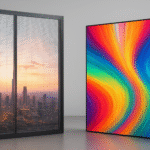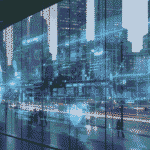Smart glass technology has become an integral part of modernizing industries. With its ability to adapt in real-time, adjusting opacity or transparency based on environmental conditions, this glass opens doors to a host of benefits that many businesses might not initially consider. While it is widely recognized for its application in architecture and automotive design, smart glass is now making a significant impact in industrial settings. In this article, explore eight unexpected benefits that smart glass brings to industries.
8 Surprising Benefits of Smart Glass in Industrial Settings
Let’s explore the top 8 Surprising Benefits of Smart Glass in Industrial Settings:
Enhanced Energy Efficiency
Energy consumption in industrial settings is a major cost driver, and smart glass is offering a dynamic solution. By automatically adjusting its transparency based on external factors such as temperature and sunlight, this swtitchable glass reduces the need for artificial heating, cooling, and lighting. This adaptive feature helps create more energy-efficient environments by regulating temperature naturally and using daylight to reduce energy consumption.
How Smart Glass Enhances Energy Efficiency:
- Reduces the need for artificial cooling and heating.
- Increases the use of natural light to reduce reliance on artificial lighting.
- Helps regulate internal temperatures by responding to weather conditions.
- Contributes to environmental goals by decreasing energy consumption.
Improved Workplace Safety
In industrial settings, safety is of paramount importance. One of the key benefits of smart glass in industrial settings is its ability to improve safety. This glass offers real-time adjustments in transparency, helping to prevent accidents by enhancing visibility. This is particularly beneficial in hazardous environments where workers need to be aware of potential dangers such as machinery malfunctions or environmental hazards. Smart glass can also integrate with sensors to monitor dangerous conditions and alert workers, further improving safety on-site.
How Smart Glass Improves Workplace Safety:
- Provides better visibility in dangerous environments.
- Offers real-time hazard alerts and warnings.
- Reduces workplace accidents by enhancing situational awareness.
- Integrates with environmental sensors for quick safety alerts.
Streamlined Maintenance and Reduced Downtime
Smart glass doesn’t just improve the environment; it also improves industrial operations. By displaying real-time data on the health and performance of machinery, this intelligent glass can alert workers and maintenance teams to potential issues before they become critical. This predictive maintenance capability reduces the risk of unexpected breakdowns and minimizes downtime, making industrial operations more efficient and cost-effective.
How Smart Glass Streamlines Maintenance:
- Displays real-time data about equipment performance.
- Alerts maintenance teams to potential issues before they cause breakdowns.
- Allows for quicker repairs with AR-based troubleshooting.
- Reduces unplanned downtime by enabling proactive maintenance.
Increased Productivity through Enhanced Communication
Smart glass enhances communication among workers in industrial environments, which directly contributes to increased productivity. Workers no longer need to stop their tasks to check emails or look up information. With switchable glass, instructions, technical specifications, and real-time updates are displayed directly in their line of sight. This hands-free approach improves workflow and reduces distractions, allowing employees to focus on their tasks and complete them more efficiently.
How Smart Glass Boosts Productivity through Communication:
- Displays real-time instructions and data without interrupting work.
- Enhances collaboration by allowing workers to communicate hands-free.
- Improves decision-making with immediate access to vital information.
- Reduces delays caused by workers searching for information.
Optimizing Space Usage and Privacy Management
In industrial settings, space is often at a premium. Smart glass allows for flexible use of space by adjusting transparency based on the needs of the moment. For example, it can provide privacy when necessary in sensitive areas, such as meeting rooms or research labs, and can switch back to transparent mode when an open layout is required. This versatility helps companies maximize the use of their available space while maintaining privacy and confidentiality when needed.
How Smart Glass Optimizes Space and Privacy:
- Adjusts opacity to create private spaces as needed.
- Eliminates the need for physical partitions, optimizing space usage.
- Provides instant privacy in areas where confidentiality is required.
- Enhances space flexibility without compromising light and openness.
Improved Employee Training and Onboarding
Training and onboarding are essential but often time-consuming processes in industrial settings. Smart glass enhances employee training by providing hands-on, real-time guidance through augmented reality (AR) overlays. This technology enables new employees to receive step-by-step instructions while performing tasks, significantly reducing training time and improving retention. This switchable glass allows workers to learn on the job, making training more efficient and accessible.
How Smart Glass Enhances Training:
- Provides AR-based instructions directly in the worker’s line of sight.
- Accelerates learning and improves knowledge retention.
- Allows employees to learn while performing tasks without needing separate training sessions.
- Reduces training costs by minimizing the need for extensive training staff or resources.
Real-Time Data Integration for Decision Making
One of the most powerful benefits of smart glass in industrial settings is its ability to integrate real-time data into the decision-making process. With live data displayed in front of workers, they can make quicker, more informed decisions. Whether it’s monitoring production progress, tracking inventory, or assessing machinery performance, smart glass ensures that workers have the most current information at all times, which leads to better decisions and faster reactions to potential issues.
How Smart Glass Integrates Real-Time Data:
- Displays up-to-date production and performance data.
- Helps workers make faster, more accurate decisions.
- Reduces errors by providing immediate access to critical information.
- Improves response times to changes in machinery or production schedules.
Enhancing Collaboration in Remote Settings
As industries continue to grow globally, collaboration across distances has become essential. Smart glass helps bridge the gap between remote and on-site workers by enabling real-time communication through augmented reality. With smart glass, on-site workers can receive instructions and troubleshooting assistance from remote experts, reducing the need for travel and speeding up problem resolution. This is particularly valuable in industries where specialized expertise is required.
How Smart Glass Enhances Remote Collaboration:
- Provides live communication with remote experts via video or AR.
- Reduces the need for expert travel, saving time and costs.
- Facilitates faster troubleshooting and problem-solving from a distance.
- Increases efficiency by allowing experts to assist workers in real-time.
Conclusion
The benefits of smart glass in industrial settings are numerous, making it a game-changing technology for businesses across various sectors. From enhancing energy efficiency and safety to increasing productivity and improving communication, smart glass offers innovative solutions that improve both operational effectiveness and the work environment. As more industries adopt this advanced technology, the advantages will continue to expand, transforming how industrial operations are managed and executed.
FAQs
How does smart glass improve energy efficiency in industrial settings?
In smart glass in industrial settings, energy consumption is significantly reduced by adjusting transparency based on external conditions. The glass darkens during hot weather to reduce solar heat gain, which lowers cooling costs, while in colder temperatures, it clears to let in sunlight, reducing heating needs. This adaptability leads to a more energy-efficient environment.
Can smart glass improve safety in industrial settings?
Yes, in industrial settings, visibility is improved, which is critical for safety. In areas like factories and warehouses, the ability to adjust the glass’s opacity allows workers to have a clear line of sight, avoiding accidents. Additionally, safety sensors can be integrated with the glass, offering real-time alerts about hazardous situations, further enhancing workplace safety.
How does smart glass streamline maintenance in industrial settings?
In smart glass in industrial settings, maintenance is simplified through real-time data display. This allows workers to monitor machinery performance and detect issues early, reducing the risk of unexpected breakdowns. Augmented reality (AR) features can also be used to guide maintenance teams in real-time, ensuring repairs are conducted efficiently and effectively.
What are the productivity benefits of smart glass in industrial settings?
The productivity is enhanced by providing workers with constant access to real-time data, performance metrics, and instructions directly on the glass. This hands-free approach eliminates the need to stop tasks and search for information, ensuring smoother workflows and more efficient operations.
How does smart glass optimize space in industrial settings?
In industrial environments, space usage is optimized by offering adjustable privacy. Workers can use the glass to create privacy when needed in environments like open-plan offices or laboratories, while still maintaining an open layout. This adaptability allows for both flexible workspace usage and confidentiality when necessary.
What is the role of smart glass in collaboration across industrial settings?
In smart glass in industrial settings, collaboration is improved by enabling real-time communication between on-site workers and remote experts. Through video calls and augmented reality-based support, workers can receive instant guidance, reducing travel time and ensuring they have access to necessary expertise, regardless of location.





